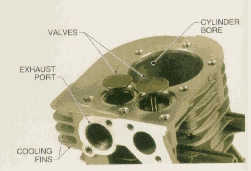
The valve train of an internal combustion engine includes components required to control the flow of gases into and out of the combustion chamber. This includes valves and related components required to allow the air-fuel mixture to enter the combustion chamber, seal the combustion chamber during compression and combustion, and evacuate exhaust gases when combustion is complete. The type of valve train used for a reciprocating engine depends on the engine design and whether the engine is a four-stroke cycle or two-stroke cycle unit.

Figure 7- Intake & Exhaust Valves
Valves allow the flow of air-fuel mixture into the cylinder, and the flow of exhaust gases from the cylinder. Most exhaust valves used in Briggs & Stratton engines are made from austenitic steel. Austenitic steel is a heat-resistive metal alloy containing of cobalt, tungsten, and chromium. and has properties similar to stainless steel. Stainless steel is a ferrous alloy alloyed with consisting of chromium or nickel. Austenitic steel used for valves offers similar heat and corrosion resistance at a lower cost than stainless steel.
Valves are exposed to various chemical, mechanical and thermal stresses during operation. They must maintain their basic shape and dimensions throughout the expected life of the engine. In addition, the integrity of the sealing surface of the valve and mating valve seat is critical to durability and performance. Engineers determine the valve material, shape, specifications, and surface coatings to match the specific engine family, expected operating environment, and projected length of service. Valves commonly used in small engines are classified as one-piece, projection-tip welded, or two-piece-stem welded-stem valves.
Each valve design utilizes components in the compression system to maintain proper valve and valve spring position in the cylinder block. A valve spring retainer maintains spring contact with the valve stem and helps to align the valve spring. Although valve spring retainers come in different styles, all provide the essential requirements of maintaining valve spring contact and spring alignment. The primary difference in valve spring retainer styles is most evident when considering valve rotation.
Most valves in an operating small engine rotate about the valve stem axis at varying rates. Valve rotation has an overall positive effect on valve life. Rotation provides improved temperature distribution in the valve head and a mild scraping action that cleans the valve interface of any crushed combustion deposits.
Valve systems equipped with the keyhole valve spring retainer produce minimal rotation. The motion of the valve is inhibited by the constant contact between the retainer and the valve spring. Each time the valve is lifted from the seat by the tappet, the retainer and valve spring apply pressure to the valve stem retainer groove. The valve spring itself influences some rotation of the valve with a keyhole valve spring retainer. The wound spiral wire of the valve spring initiates a small torque through the retainer into the valve stem, which causes some rotation.
The valve seat mates with the valve face to seal the combustion chamber. In addition to the sealing function, the valve seat also removes a significant amount of the heat away from the valves. Two common types of valve seats are the integrally machine valve seat and the valve seat insert.